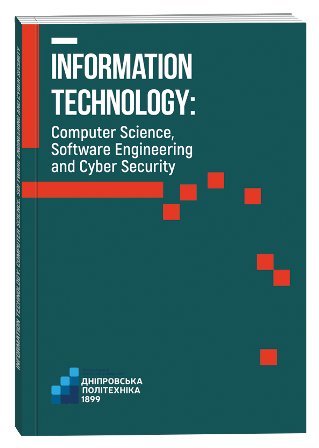METHODOLOGICAL FOUNDATIONS OF INFORMATION TECHNOLOGIES FOR THE ANALYSIS OF MULTI-CHANNEL AEROSPACE IMAGES
DOI:
https://doi.org/10.32782/IT/2024-4-19Keywords:
machine learning methods, multi-channel space images, information technologies, neural networks, geo-information systems.Abstract
The article analyzes the methodological foundations of information technologies used for processing and analysis of multi-channel aerospace images. Modern space satellites provide high-quality images in various spectral ranges, which opens up new opportunities for monitoring Earth processes and studying the environment. The purpose of the work is to identify the key stages and technologies that provide effective analysis of multichannel aerospace images. The research methodology consists in the integration of modern information technologies for comprehensive analysis of multi-channel aerospace images. The initial stage involves data preprocessing, which includes geometry correction, atmospheric correction, and brightness normalization. These processes are necessary to eliminate distortions that can affect the accuracy of the analysis. Further spectral analysis is critical for object classification in images. The use of algorithms such as support vectors (SVM) and random forest (Random Forest) allows you to automate the classification process and increase its accuracy. The article also considers spatial analysis, which involves the study of spatial relationships between objects. Geostatistical methods, such as interpolation, are used to estimate the spatial distribution of various phenomena occurring on the Earth’s surface. This approach is especially important for studying changes in landscapes and their structural characteristics. Temporal analysis based on time series is another important aspect that allows researchers to monitor changes in land cover, infrastructure development, and ecological processes. Using such data is essential for studying trends and predicting future changes. The article focuses on the application of modern information technologies, in particular, geographic information systems (GIS) and machine learning methods, which significantly increase the efficiency of the analysis of multi-channel space images. The integration of these technologies allows for accuracy and efficiency in research related to the environment and contributes to a better understanding of global changes on the planet. The scientific novelty of the research lies in the creation of methodological foundations and the development of modern information technologies for the analysis of multi-channel aerospace images. The paper proposes a sequence of image processing steps based on the new technology of geometric and spectral correction of space images of high spatial resolution developed at NTU «DP», taking into account the physical mechanisms of information fixation and the deep learning algorithm developed by the authors with pre-processing of images for the decision support system. The conclusions of the article emphasize the importance of further development of methods and technologies in this field, as well as the need for an interdisciplinary approach to ensure comprehensive analysis and monitoring. The methodological foundations of processing multi-channel aerospace images developed in the work and the improved technique of their analysis allow creating an information system for decision-making support for aircraft control based on primary images, taking into account objects located on the earth’s surface.
References
Adegun A. A., Viriri S., Tapamo J. R. Review of deep learning methods for remote sensing satellite images classification: Experimental survey and comparative analysis. Journal of Big Data. 2023. Vol. 10. № 93. P. 1–24.
Aziukovskyi O., Hnatushenko V., Zavizion V., Olevskyi V., Bulana T., Ivanov D., Gadiatskyi V. Decision Support System Oncoassist for Breast Cancer Computer-Aided Diagnostic. Інтелектуальні системи прийняття рішень і проблеми обчислювального інтелекту (ISDMCI’2024): матеріали XX міжнародної наукової інтернет-конференції. Херсон: Книжкове видавництво ФОП Вишемирський В., 2024. С. 21–22.
Gonzalez R. C., Woods R. E. Digital image processing (4th ed.): Pearson Education, 2018. 1019 p.
Han W., Zhang X., Wang Y., Wang L., Huang X., Li J., Wang Sh., Chen W., Li X., Feng R., Fan R., Zhang X., Wang Y. A survey of machine learning and deep learning in remote sensing of geological environment: Challenges, advances, and opportunities. ISPRS Journal of Photogrammetry and Remote Sensing. 2023. № 202. P. 87–113.
Hansen M., Loveland T. A review of large area monitoring of land cover change using Landsat data. Remote Sensing of Environment. 2012. № 122. P. 66–74.
Jensen J.R. Remote sensing of the environment: An earth resource perspective (2nd ed.): Pearson Education, 2009. 592 p.
Kashtan V. Yu., Shedlovska Y. I., Hnatushenko V. V. Processing technology of multispectral remote sensing images. International Young Scientists Forum on Applied Physics, Lviv, October 16–20 2017. Lviv, 2017. P. 355–358.
Kogan F. Remote sensing land surface changes. Springer, Cham. 2022. 462 p.
Lillesand T., Kiefer R. W., Chipman J. Remote sensing and image interpretation (7th ed.): John Wiley & Sons, 2015. 768 p.
Mather P. M., Magaly K. Computer processing of remotely-sensed images: An introduction (4th ed.). John Wiley & Sons, 2011. 464 p.
Olevskyi V. I., Olevska Yu. B., Olevskyi O. V., Hnatushenko V. V. Raster image processing using 2D Padé-type approximations. Journal of Physics: Conference Series. 2023. Vol. 2675. № 1. P. 012015.
Shevchenko V. Yu., Hnatushenko V. V., Kavats O. O. Pansharpening technology of high-resolution multispectral and panchromatic satellite images. Naukovyi Visnyk NGU. 2015. Vol. 4. № 148. P. 91–98.
Гнатушенко В. В., Олевська Ю. Б., Олевський В. І. Методи апроксимації рядами та їх застосування в біологічних і технічних задачах. Кременчук : Видавництво «НОВАБУК», 2024. 202 с.
Каштан В. Ю., Гнатушенко В. В. Інформаційна технологія підвищення інформативності багатоканальних даних на основі пакетних вейвлет-перетворень. Комп’ютерно-інтегровані технології: освіта, наука, виробництво. 2016. С. 77–83.
Каштан В. Ю., Гнатушенко В. В. Технологія геометричної та спектральної корекцій оптико-електронних космічних знімків. Вісник ХНТУ. 2017. Вип. 3. № 62. С. 286–291.
Поляков М. Нові можливості супутникових сенсорів: як змінилася EOS-індустрія за минулі роки. URL: https://maxpolyakov.com/ua/novi-mozhlivosti-suputnikovikh-sensoriv-yak-zminilasya-eos-industriya-zaminuli-
roki/ (дата звернення: 24.09.2024).
Шевченко В. Ю., Гнатушенко В. В., Кавац О. О. Підвищення просторового розрізнення багатоканальних аерокосмічних зображень високого просторового розрізнення на основі гіперсферичного перетворення. Науковий журнал Запорізького національного технічного університету, радіоелектроніка, інформатика, управління. 2015. Вип. 1. № 32. С. 73–79.







